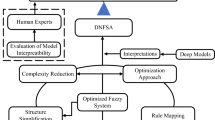Abstract
The main objective of this paper is to propose a Neuro-Fuzzy network, which can model a system from input–output data by automatically dividing the input–output space and extracting fuzzy if-then rules from numerical data. The structure of the network is simple with input, rule and output layers only. The connections between input and rule layer is used to derive the membership functions of the fuzzified part. Kohonen’s self-organizing learning algorithm is applied to partition the pattern space. Using this algorithm, similar rules are mapped close by and extraction of if-then rules is made easy. It can also adapt to a number of rules automatically. The proposed network is verified for three benchmark applications. Experimental results show that the adaptive method discussed in this paper not only trains in a few hundred iterations but also provides better performance measures when compared to conventional methods.











Similar content being viewed by others
Explore related subjects
Discover the latest articles, news and stories from top researchers in related subjects.References
Zadeh LA (1988) Fuzzy logic. IEEE Comp Mag 83–93
Buckley JJ, Hayashi Y (1993) Hybrid neural nets can be fuzzy controllers and fuzzy expert systems. Fuzzy Set Syst 60:135–142
Su M, Chan H (1998) Extracting rules from composite neural networks for medical diagnostic problems. Neural Process Lett 8:253–263
Buckley JJ, Feuring T (1999) Fuzzy and neural: Interactions and Applications. Physica-Verlag, Heidelberg
Scharf EM, Mandic NJ (1985) The application of a fuzzy controller to the control of a multi-degree-freedom robot arm. In: Sugeno M (ed) Industrial Application of Fuzzy control. Amsterdam, pp 41–62
Sugeno M, Nishida M (1985) Fuzzy control of model car. Fuzzy Set Syst 16:103–113
Sejnowski T, Rosenberg C (1986) NETTalk: a parallel network that learns to read aloud. JHU/EECS-86/01, ech.Rep.EECS Department, Johns Hopkins University
Barto AG, Sutton RS, Anderson CW (1983) Neuronlike adaptive elements that can solve difficult learning control problems. IEEE Trans Syst Man Cybern SMC-13(5):834–847
Jang JR (1993) ANFIS: adaptive network based fuzzy inference system. IEEE Trans Syst Man Cybern 23(3):665–685
Amano A, Aritska T (1989) On the use of neural networks and fuzzy logic in speech recognition. In: Proceeding of international joint conference on neural networks, pp 301–305
Lee CC, Berenji HR (1989) An intelligent controller based on approximate reasoning and reinforcement learning. In: Proceeding of IEEE Intelligent machine, pp 200–205
Kosko B (1987) Adaptive inference in fuzzy knowledge networks. In: Proceeding of international joint conference on neural networks, pp 261–268
Lin Y, Vonseelen W, Sendhoff B (1998) An approach to rule-based knowledge extraction. In: Proceedings of IEEE interenational conference on fuzzy system. FUZZ-IEEE’98, Anchorage, pp 1188–1193
Mitra S, Hayashi Y (2000) Neuro-Fuzzy Rule Generation: Survey in Soft computing framework. IEEE Trans Neural Netw 11(3):748–768
Pal K, Pal NR (1998) A Neuro-Fuzzy system for inferencing. Int J Intell Syst 14:1155–1182
Krishnan R, Sivakumar G, Bhattacharya P (1999) A search technique for rule extraction from trained neural networks. Pattern Recog Lett 20:273–280
Kohonen T (1990) The self organizing map. Proc IEEE 78:1464–1480
Sugeno M, Yasukawa T (1993) A fuzzy logic based approach to Qualitative modeling. IEEE Trans Fuzzy Syst 1(1):7–31
Box GEP, Jenkins GM (1970) Time series analysis, forecasting and control. Holden Day, San Francisco
Lin Y, Cunningham G (1994) Building a fuzzy system from input–output data. J Intell Fuzzy Syst 2(3):243–250
Tikk D, Baranyi P (2000) Comprehensive analysis of a new fuzzy rule interpolation method. IEEE Trans Fuzzy Syst 8(3):281–296
Pedrycz W (1998) Computational Intelligence: an introduction. CRC, Boca Raton
Author information
Authors and Affiliations
Corresponding author
Rights and permissions
About this article
Cite this article
Shalinie, S.M. Modeling Connectionist Neuro-Fuzzy network and Applications. Neural Comput & Applic 14, 88–93 (2005). https://doi.org/10.1007/s00521-004-0452-x
Received:
Accepted:
Published:
Issue Date:
DOI: https://doi.org/10.1007/s00521-004-0452-x




